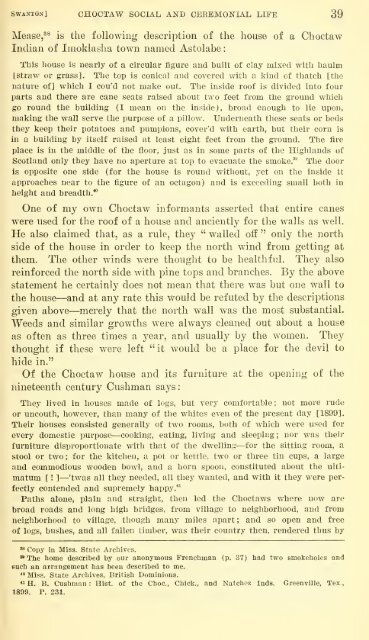siOBX; - Smithsonian Institution
siOBX; - Smithsonian Institution
siOBX; - Smithsonian Institution
Create successful ePaper yourself
Turn your PDF publications into a flip-book with our unique Google optimized e-Paper software.
SWANTON] CHOCTAW SOCIAL AND CEREMOISriAL LIFE 39<br />
Mease,^^ is the following description of the house of a Choctaw<br />
Indian of Imoklasha town named Astolabe<br />
This house is nearly of a circular figure and built of clay mixed with haulm<br />
Lstraw or grass]. The top is conical and covered with a kind of thatch [the<br />
nature of] which I cou'd not make out. The inside roof is divided into four<br />
parts and there are cane seats raised about two feet from the ground which<br />
go round the building (I mean on the inside), broad enough to lie upon,<br />
making the wall serve the purpose of a pillow. Underneath these seats or beds<br />
they keep their potatoes and pumpions, cover'd with earth, but their corn is<br />
in a building by itself raised at least eight feet from the ground. The fire<br />
place is in the middle of the floor, just as in some parts of the Highlands of<br />
Scotland only they have no aperture at top to evacuate the smoke.^" The door<br />
is opposite one side (for the house is round without, yet on the inside it<br />
approaches near to the figure of an octagon) and is exceeding small both in<br />
height and breadth.*"<br />
One of my own Choctaw informants asserted that entire canes<br />
were used for the roof of a house and anciently for the walls as well.<br />
He also claimed that, as a rule, they " walled off " only the north<br />
side of the house in order to keep the north wind from getting at<br />
them. The other winds were thought to be healthful. They also<br />
reinforced the north side with pine tops and branches. By the above<br />
statement he certainly does not mean that there was but one wall to<br />
the house—and at any rate this would be refuted by the descriptions<br />
given above—merely that the north wall was the most substantial.<br />
Weeds and similar growths were always cleaned out about a house<br />
as often as three times a year, and usually by the women. They<br />
thought if these were left "it would be a place for the devil to<br />
hide in."<br />
Of the Choctaw house and its furniture at the opening of the<br />
nineteenth century Cushman says:<br />
They lived in houses made of logs, but very comfortable; not more rude<br />
or uncouth, however, than many of the whites even of the present day [1899].<br />
Their houses consisted generally of two rooms, both of which were used for<br />
every domestic purpose—cooking, eating, living and sleeping ; nor was their<br />
furniture disproportionate with that of the dwelling—for the sitting room, a<br />
stool or two ; for the kitchen, a iwt or kettle, two or three tin cups, a large<br />
and commodious wooden bowl, and a horn spoon, constituted about the ultimatum<br />
[ ! ]—'twas all they needed, all they wanted, and with it they were per-<br />
fectly contended and supremely happy .^^<br />
Paths alone, plain and straight, then led the Choctaws where now are<br />
broad roads and long high bridges, from village to neighborhood, and from<br />
neighborhood to village, though many miles apart; and so open and free<br />
of logs, bushes, and all fallen timber, was their country then, rendered thus by<br />
^ Copy in Miss. State Archives.<br />
"The home described by our anonymous Frenchman (p. 37) had two smokeholes and<br />
such an arrangement has been described to me.<br />
^° Miss. State Archives, British Dominions.<br />
*i H. B. Cushman : Hist, of the Choc, Chiclj., and Natchoz Inds. Greenville, Tex.,<br />
1899. P. 231.

















